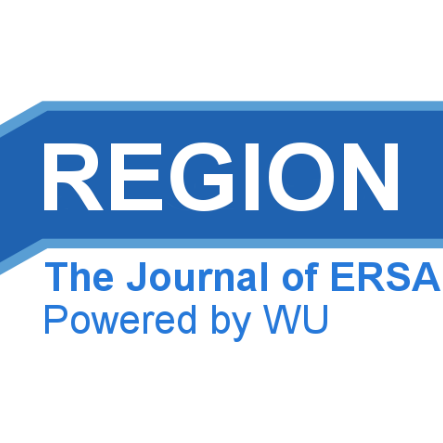A multilevel path analysis of social networks and social interaction in the neighbourhood
DOI:
https://doi.org/10.18335/region.v2i1.32Abstract
The topic of neighbourhood-based social interactions has gained attention in the last decades in the light of urban policies that aim to deal with problems regarding social segregation and exclusion, quality of life and liveability in urban areas. Social interactions are expected to play an important role in dealing with these problems. However, empirical studies investigating to which extent neighbourhood characteristics can improve social contacts among residents are scarce and inconclusive. Therefore, this paper studies the role of socio-demographics and neighbourhood characteristics in the formation of social network ties and social interactions with neighbours. Based on data collected in 2011 in 70 different neighbourhoods of Eindhoven in the Netherlands in a survey among 751 respondents these relationships are analysed using a multi-level path analysis approach. The results indicate that neighbourhood-based contacts are influenced by personal and household characteristics, such as education, income, work status, ethnicity, household composition, and years at the current address. Neighbourhood characteristics are not found to affect social network size, the share of neighbours in the network or the frequency of interaction with neighbours.References
Atkinson, R. and Kintrea, K. 2001. Disentangling area effects: Evidence from deprived and non-deprived neighbourhoods. Urban Studies 38 (12) 2277-2298.
Bridge, G. 2002. The neighbourhood and social networks. Centre for Neighbourhood Research, paper 4, http://www.neighbourhoodcentre.org.uk
Fischer, C.S. 1982. To dwell among friends: personal networks in town and city. Chicago: University of Chicago Press.
Forrest, R. and Kearns, A. 2001. Social cohesion, social capital and the neighbourhood. Urban Studies, 38 (12) 2125-2143
Galster, G. 2007. Should policy makers strive for neighbourhood social mix? An analysis of the Western European evidence base. Housing studies 22 (4) 523-545.
Golob, T. 2001. Structural Equation Modeling for travel behaviour research. Transportation Research Part B 37 1-25.
Guest, A.M. and Wierzbicki, S.K. 1999. Social ties at the neighbourhood level: two decades of GSS evidence. Urban Affairs Review 35 (1) 92-111.
Hogan, B., J.A. Carrasco, and B. Wellman. 2007. Visualizing Personal Networks: Working with Participant-Aided Sociograms, Field Method, 19 (2) 116-144.
Jöreskog, K. and D. Sörbom. 2001. LISREL 8.5 Scientific Software International
Kleinhans, R. 2004. Social implications of housing diversification in urban renewal: a review of recent literature. Journal of Housing and the Built Environment, 19, 367-389
McCarty, C., P.D. Killworth, H.R. Bernard, E.C. Johnsen, and G.A. Shelley. 2000. Comparing two methods for estimating network size. Human Organization. 60, 28-39.
Pinkster, F. and Völker, B. 2009. Local social networks and social resources in two Dutch neighbourhoods. Housing studies, 24 (2) 225-242.
Putnam, R. 2000. Bowling Alone: The Collapse and Revival of American Community. New York: Simon & Schuster
Thomése, F. and van Tilburg, T. 2000. Neighbouring networks and environmental dependency. Differential effects of neighbourhood characteristics on the relative size and composition of neighbouring networks of older adults in The Netherlands. Ageing and Society 20, 55-78.
Van Beckhoven, E. and Van Kempen, R. 2003. Social effects of urban restructuring: a case study in Amsterdam and Utrecht, the Netherlands. Housing Studies, 18 (6) 853-875
Van den Berg, P., Arentze, T. and Timmermans, H. 2009. Size and composition of ego-centered social networks and their effect on geographical distance and contact frequency. Transportation Research Record. Vol. 2135, 2009, pp. 1-9.
Van den Berg, P.E.W., Arentze, T.A. and Timmermans, H.J.P. 2012. Involvement in clubs or voluntary associations, social networks and activity generation: a path analysis. Transportation. 29 (4) 843-856.
Van Eijk, G. 2010. Does living in a poor neighbourhood result in network poverty? A study on local networks, locality-based relationships and neighbourhood settings. Journal of Housing and the Built Environment, 25: 467-480.
Völker, B. and Flap, H. 2007. Sixteen million neighbors. A multilevel study of the role of neighbors in the personal networks of the Dutch. Urban Affairs Review 43 (2) 256-284.
Washington, S., Karlaftis, M., and F. Mannering. 2003. Statistical and Econometric Methods for Transportation Data Analysis. Chapman & Hall, Washington D.C.
Wellman, B. 1979. The community question: The intimate network of East Yorkers. American Journal of Sociology 84, 1201-31.
Wellman, B. 2001. Physical space and cyberspace: the rise of personalized networking. International Journal of Urban and Regional Research, 25 (2) 227-52.
Published
How to Cite
Issue
Section
License
REGION is an open journal, and uses the standard Creative Commons license: Copyright We want authors to retain the maximum control over their work consistent with the first goal. For this reason, authors who publish in REGION will release their articles under the Creative Commons Attribution license. This license allows anyone to copy and distribute the article provided that appropriate attribution is given to REGION and the authors. For details of the rights authors grant users of their work, see the "human-readable summary" of the license, with a link to the full license. (Note that "you" refers to a user, not an author, in the summary.) Upon submission, the authors agree that the following three items are true: 1) The manuscript named above: a) represents valid work and neither it nor any other that I have written with substantially similar content has been published before in any form except as a preprint, b) is not concurrently submitted to another publication, and c) does not infringe anyone’s copyright. The Author(s) holds ERSA, WU, REGION, and the Editors of REGION harmless against all copyright claims. d) I have, or a coauthor has, had sufficient access to the data to verify the manuscript’s scientific integrity. 2) If asked, I will provide or fully cooperate in providing the data on which the manuscript is based so the editors or their assignees can examine it (where possible) 3) For papers with more than one author, I as the submitter have the permission of the coauthors to submit this work, and all authors agree that the corresponding author will be the main correspondent with the editorial office, and review the edited manuscript and proof. If there is only one author, I will be the corresponding author and agree to handle these responsibilities.





